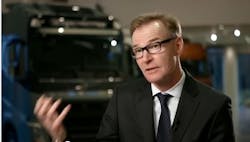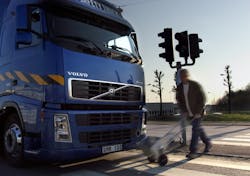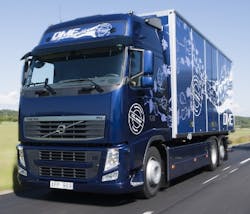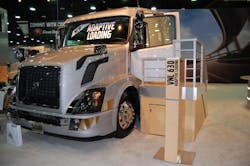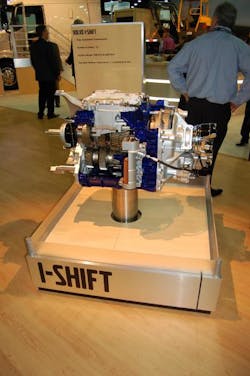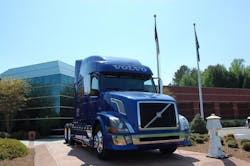Volvo AB’s Persson: safety and sustainability driving product development
LOUISVILLE, KY. Some 900 people packed a meeting room at 7:00 a.m. Friday morning for the 25th annual Heavy-Duty Aftermarket Association “Breakfast & Briefing” here at the Mid-America Trucking Show. The keynote speaker, Olof Persson, president of AB Volvo and chief executive officer of the Volvo Group, brought with him from Sweden a global perspective on surface transportation that reflected the increasingly global nature of many of the companies represented in the audience and on the trade show floor.
Persson himself is a reflection of the global future. He is a member of the European Roundtable of Industrialists and of the Royal Swedish Academy of Engineering Sciences. In August of 2014, he was also appointed co-chairman of a high-level Advisory Group formed by United Nations secretary-general, Ban Ki-Moon, to consider “Sustainable Transport.”
“It is great to be back in the United States,” he told the audience. Volvo has a major presence in North America, having invested $1.4 billion here since 2002.
Broadly speaking, North American is presently enjoying the best economy in the world, Persson observed. The outlook for Europe in 2015 is essentially flat; South America is a “slow market,” with low GDP growth and decreased business; and Asia’s future is “mixed;” while North America is strong once again. He then took a look at the major trends giving shape to the future, including demands for increased safety, environmental goals, integration and connectivity.
Societal demand for increased safety:
“The first of these [trends affecting the industry] is the increasing societal demand for safety,” Persson said. “This is certainly in evidence here in the U.S., in the wake of several terrible, well-publicized accidents last year involving trucks.
“I think we’re all very much aware of the many factors that will continue to drive this trend. There is congestion and the stress on aging and inadequate infrastructure,” he added. “There is increased freight movement from general economic growth, combined with increased local delivery traffic from the rise in online shopping. There is also increased awareness of, and desire for, the technologies that either already exist – for example in the auto industry – or are in development. All of this will drive increasing interest in shifting our approach from passive to active safety systems.“Safety has been a Volvo core value since our founding, and we are continuing to work on a variety of active safety technologies,” he noted; pointing for instance to Volvo's 360-system that monitors all of the truck’s surroundings for the driver and suggests actions to avoid accidents, whether they involve pedestrians, cyclists, or other vehicles.
"We think that a few years from now the vehicle will have a 360-degree ‘awareness’ of what’s going on around it, and will even be able to predict what the moving entities it is scanning might do next. If the driver does not respond to suggested actions, the steering or braking system will be activated autonomously," he explained.
Though Volvo still have several technical challenges to overcome, he thinks it’s possible this technology could be become a reality in five to ten years from now.
“When it comes to traffic safety, our vision is a bold one – to have no accidents involving Volvo trucks. This technology has the potential to take us another step toward that vision, and it represents the kind of advancement that society will increasingly expect from our industry,” Persson said.
Environmental goals will drive product complexity:
“I was recently named co-chair of the UN advisory group on sustainable transport, and from that position, I can tell you that environmental issues will continue to be at the forefront of what society demands from all of us, here and around the world,” Persson observed.
“The ‘buzz’ around alternative fuels may have dampened a bit recently in the U.S. due to oil prices and domestic supply, but this is temporary. Forty-five dollars a barrel won’t last forever, and governments here and around the world will continue to have emissions in general – and greenhouse gas in particular – in focus," he said.
“I recognize that natural gas has gotten the most attention in the U.S., for obvious reasons. And our view is that natural gas will continue to play a role in some segments of this market – particularly in certain vocational applications, and shorter, regional hauls,” Persson said.“But when it comes to other segments, particularly longer hauls, we continue to believe DME (dimethyl ether) shows tremendous promise,” he observed. “Converting natural gas to DME is an innovative way to address many of the distribution, storage and fueling challenges otherwise presented by natural gas – particularly liquefied natural gas – as a heavy truck fuel."
He said Volvo will continue to work with this technology and we hope the industry as a whole will get more interested in it as time goes on – though if the industry were able to get the critical mass of production volume needed, "DME could really be a game-changer,” Persson said.
“Of course, one of the biggest short-term environmental issues in this market today is the second phase of the U.S. greenhouse gas regulations. A major issue from our perspective is whether or not there will be a separate engine standard, in addition to the complete vehicle standard,” he noted.
“First of all, it seems to us a separate engine standard would be redundant, since the engine would be accounted for in the complete vehicle assessment," Persson emphasized. "And the last time I looked, there were no loose engines pulling freight down American highways."
But more important than redundancy, an engine standard – particularly if it’s stringent – could force the use of technologies that could bring seriously negative consequences for our customers, in terms of cost, weight, space, cooling, and so on, he warned."The vehicle as a whole is becoming a more and more complex system, and regulating efficiency only for the engine, or any other component, risks sub-optimization," Persson added. "This works against the ultimate goal of having a more efficient freight system."
If reason does not prevail, he said the industry could be faced with a mandate for increased engine efficiency that actually reduces total vehicle efficiency in real-world conditions. "That would obviously be a loss not just for truck customers, but for society and the environment," Persson cautioned.
"We’ve demonstrated with innovations like our automated manual transmissions and adaptive gearing packages – neither of which are mandated, or even accounted for in the current regulations – that we can and will develop creative solutions that meet the needs of society, while meeting the needs of our customers," he said.
"We also should avoid an engine standard that forces different technologies in the U.S. than other parts of the world. Our engines are finally approaching common architecture worldwide, bringing significant savings in development and unit cost," Persson noted; a trend that’s very much in the interest to Volvo's customers, and of the economy as a whole, and should be continued, he stressed.
"Finally, just a quick comment about an issue that’s recently come to my attention – so-called 'glider kits.' While these kits might serve a legitimate need in some instances, in the worst cases, they are effectively allowing older, dirtier engines to be put in a new truck," Persson said.
"From the outside looking in at the U.S., which has always led the world in stringent environmental regulations, I find it curious that this practice is so broadly permitted. It also appears to be growing," he pointed out. "I’ll just say that given our commitment to the environment, it’s not a business that Volvo Group companies will be involved in."
Integration key to meeting stakeholder demands:
“We believe that powertrain integration is the most effective and efficient way to manage the kind of complexity I’ve just talked about – whether it’s driven by environmental regulations or by customer demands for increased fuel economy and performance,” Persson said. “Having components that were specifically designed for each other and act seamlessly together allows us to create more and more intelligent, higher-performing vehicles.“I mentioned earlier the fuel economy advancements made possible by matching automated manual transmissions with our engines. This pairing has also unlocked exciting potential for better delivering higher horsepower and torque from smaller engines – improving the “density” of our powertrains,” he noted.
“We’re now able to deliver 505 horsepower and 1,860 pound-feet of torque, from a 13-liter engine. And smart shifting from I-Shift and mDRIVE transmissions allows us to make more of that power useable, throughout the vehicle’s workday," Persson noted.
"The technological march toward getting more power from smaller packages – in everything from computers, to batteries, to passenger car engines – won’t just skip over the heavy vehicle industry," he stressed.
"I understand there is a saying in the U.S. that 'there’s no replacement for displacement.' But there is a replacement for displacement – it is innovation. And integration is helping us drive innovation,” Persson stated.
Connectivity will deliver uptime breakthroughs:
“The heavy-duty truck is certainly becoming part of ‘the internet of things’ – the skyrocketing number of devices, appliances and so on, connected to the internet,” Persson noted. “And we are rapidly approaching the point at which no trucks will ever really be “offline.” This offers many opportunities to significantly reduce customers’ total cost of operation,
“Today, there is justifiably a tremendous amount of customer interest in fuel economy, and every tenth of a percent increase we can deliver is precious. But if you did the calculation, I wonder how much of even, say, a year’s worth of savings from a three percent fuel economy improvement, would be undercut by just one day of unplanned downtime – especially after you factor in the consequences for the trucking company’s reputation and for customer relationships,” he offered.“So uptime is a very strong focus area for both of our truck brands in North America, and one in which we think connectivity is key. Our North American Mack and Volvo brands already have more than 80,000 vehicles on the road equipped with remote diagnostics systems,” Persson stated. "These systems have demonstrated the ability to reduce the average diagnostic time by up to 70 percent and average repair times by more the 20 percent – but we’ve only scratched the surface."
He added that those systems will ultimately allow us to become increasingly proactive in making changes to the vehicle wirelessly, on-the-fly – either to correct problems, or to optimize for things like terrain, temperature, or other operating conditions.
“In short, we’re working toward a 'wireless workshop' where trucks are in some cases evaluating themselves, while in operation, and being repaired remotely," Persson emphaszied.
“But while we’re very excited about the technology, it’s also clear to us that the real gains can’t be made with technology alone. People – skilled, knowledgeable personnel – are essential components,” he noted. “Among other things, these experts help customers and dealers turn the large amount of available data into actionable information – information they can use to better manage their business.”
At the end of the day, no matter how high-tech products and services become, trucking is, ultimately, a people business, stressed Persson. "It's a relationship business. And there are many occasions on which there is just no substitute for having a human being on the line, helping you work through your issues,” he added.“It’s because we believe so strongly in having the right mix of technology and expert personnel that we recently invested in a new Uptime Center at our North Carolina headquarters. The Center co-locates personnel from every customer support function, so getting together face-to-face on short notice is easy. These are people who know our products, and understand our customers’ business – and who are now connected to both our customers and our dealers with the latest telematics, communications, and case management tools," he said. “Again, this is an area that holds huge potential for our industry, and for society. And it is certainly an area in which we look forward to working with suppliers to continue delivering innovative solutions.”
During the question and answer session, Persson stressed again the company’s sense of obligation to serve society as a whole. “[Helping to] create a good, clean and safe society has to be part of what we do,” he observed.
When asked about the obstacles he sees as impeding the implementation of advanced technologies, Persson was clear and to the point: first of all, there are legislative issues, he noted. Legislatures move slowly; technology moves fast. Then, there is a trust issue when it comes to new technologies. Technology is really an add-on to what we are used to and it takes time to accept that and be comfortable with it. Finally, every technology we implement has to make sense.
Persson was also asked how Volvo views its supply base - a question of particular interest to the audience. “We are all friends here,” he said, adding that Volvo is looking for five basic things from suppliers:
- Suppliers who can drive in and bring in innovation.
- Suppliers who can help do research and development.
- Suppliers who can serve our global market with us.
- Suppliers who understand pricing and the need to be competitive
- Suppliers who deliver product excellence.
About the Author
Wendy Leavitt
Wendy Leavitt is a former FleetOwner editor who wrote for the publication from 1998 to 2021.
